Machine learning (ML) seems to be the latest buzzword in tech, but anyone who treats it as another passing mania may have serious regrets. From Amazon to Netflix, machine learning has proved to be one of the most significant disruptors since the iPhone. Even as I write this article, words appear ahead of my thoughts with a word prediction algorithm. Thank you, Google. It’s scary, amazing, and a little unnerving. But it’s here, whether we like it or not.
In fact, you already may be using machine learning without realizing it. As Spotify serves up your favorite music and Amazon fills its warehouses with items you’re about to order, machine learning has already enhanced many of our online experiences, and its power is set to increase exponentially in the coming years.
But machine learning also has a dark side. In the wrong hands, this powerful technology can be highly manipulative. From privacy and surveillance concerns to an increase in cyberthreats, machine learning poses a host of new dangers. But in the right hands and with proper oversight, machine learning is one of the most promising business tools available to us today. Better to understand and harness that power than to wish it away. For those of you seeking a better understanding of machine learning and how you can leverage its power for your own business applications, here’s a three-part series on the basics of machine learning, starting with Machine Learning: a 90-second primer.
Machine Learning: a 90-second primer
Machine learning (ML) is a type of artificial intelligence that uses raw data and repeatable patterns to learn and improve new ways to solve a problem. In effect, it’s a computer system that trains itself through trial and error – finding patterns in data without the need for human programmers. It’s a machine that learns on its own, building its own algorithm in the process.
One of the most common examples of machine learning is a self-driving car. Rather than using a traditional programming model, which relies on computer programmers to feed it step-by-step instructions, an autonomous vehicle uses sensory input and object recognition to create a digital map, continually building on its own neural network to classify images and develop predictive capabilities. In effect, an autonomous car learns as it drives.
Other well-known examples of machine learning include facial recognition, spam detection, predictive speech, and our favorite virtual personal assistants, Siri, Alexa, Cortana, and, well … Google Assistant. As the list of machine learning applications grows daily, many of us would love a better understanding of how machine learning really works and how we might also leverage its power to advance our own business objectives.
Traditional programming, the precursor to machine learning
To better understand machine learning, it’s helpful to first take a look at its predecessor, traditional programming.
Traditional computing actually dates back to 1843 and simply refers to any manually created program that uses sets of data, human-defined rules, and common scenarios to reach solutions.
For example, let’s say we want a computer to identify various types of balls used in sports. At the most basic level, we would write a program, or an algorithm, that would use known data and applied rules to determine how to categorize each ball type. A sample set of rules would include if-then statements with a codified path of logic. A programmer would compile ball features, such as round, white, >235mm, >149g and arrange that data into a logical, systematic code, like this basic example below.

By collecting and inputting data such as size and color, and creating a simple set of rules like “if-then-else,” a computer should be able to categorize each ball type or, as coders say, “reach a solution.”
But traditional code such as this has its limitations. For example, if we start with an image of a ball, we need to extract the ball from the rest of the image. Anyone who uses design tools, knows this process will likely yield unreliable results, given the lighting, shadows, and placement of the ball on a surface.
A second challenge relates to math. Since a football is an oval shape, we would need to make an oval-shape detector, which is difficult to put in an algorithm because we would need to determine the possible arcs and roundness ratio.
A third challenge focuses on the orientation of a football in the image. Are we looking at the football from the pointed side? If so, the football would then appear round rather than oval.
Now let’s try a soccer ball. Again, we run into a series of challenges. Is it a soccer ball or a dart board? What if the pic was shot in shadows? Is the ball still black and white? You can imagine any number of scenarios that would demonstrate the complexity and unreliability of rule-based programming.
Traditional programming: A decision tree

This is a simplified graphic representation of a decision tree. The illustration underscores the many limitations of traditional programming.
New data? Not a problem
Enter machine learning. Unlike traditional programming, which uses a method that relies on data scientists to gather and feed data into an appropriate model, machine learning overcomes the limitations of traditional programming by using a training process that will infer repeating patterns from a series of training images. Using the ball example, a machine learning algorithm will adapt to recognizing each ball type by its many properties such as edge, line, color, and shape. It then uses these repeating patterns as data parameters, or rules when exposed to new data – for predicting new types of balls. Imagine a system that can instantly recognize any new ball type among millions of images without needing to be preprogrammed. Now imagine that same code applied to X-ray classification, plant disease identification, and even satellite image analysis. This generalization capability, or the ability to process new, previously unseen data is ML’s defining feature.
Power of prediction
Equally impressive to machine learning’s generalization capability are its predictive capabilities. Given the ability to process massive amounts of data while continuing to learn without predefined rules, a machine learning system will continually grow and change when exposed to new data. This predictive capability, when applied to business, enables teams to manage highly complex challenges with extraordinary speed and efficiency. Businesses that embrace machine learning early can jump lightyears ahead of their competition.
Machine learning, within reach
So where does that leave mid-sized and small businesses? Many of us recognize that Big Tech has used machine learning to transform its business models and will continue to rely on machine learning to keep start-ups at bay. But, no need to look at Big Tech with envy. Machine learning is also attainable to smaller organizations that are looking for rapid growth. Nearly any organization can apply machine learning principles. All you need are clearly defined goals and some professional guidance.
Want to get started?
Watch for our next blog post on machine learning, and we’ll show you how.



